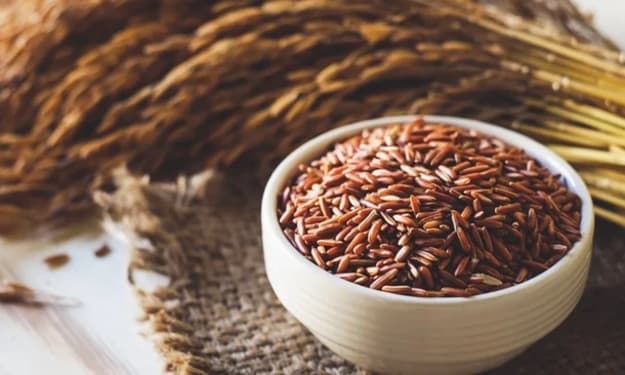10 Easy Ways to Lower Blood Sugar Levels Naturally
Discover A Method To Support Healthy Blood Sugar Levels

Diabetes and prediabetes are linked to high blood sugar, often known as hyperglycemia. Prediabetes is defined as having high blood sugar levels but not being diabetic.
Normally, your body maintains blood sugar levels by making insulin, a hormone that helps your cells to utilize the sugar in your blood. As a result, insulin is the most significant blood sugar regulator.
However, a variety of circumstances can compromise blood sugar control and result in hyperglycemia.
Internal reasons of high blood sugar include your liver producing too much glucose, your body producing insufficient insulin, or your body's inability to efficiently utilise insulin. Insulin resistance is the term for the latter.
Dietary habits, certain drugs, a sedentary lifestyle, and stress are all external variables.
According to the Centers for Disease Control and Prevention (CDC), 13% of individuals in the United States have diabetes, while another 34.5% have prediabetes. This indicates that nearly half of all individuals in the United States have diabetes or prediabetes.
Blood sugar control is especially crucial for diabetics since chronically high blood sugar levels can cause limb and life-threatening consequences.
Here are 14 simple and scientifically proven strategies to naturally reduce your blood sugar levels.
1. Exercise regularly
Regular exercise can help you achieve and maintain a healthy weight while also increasing insulin sensitivity.
Increased insulin sensitivity implies that your cells can utilise the available sugar in your circulation more efficiently.
Exercise also aids in the use of blood sugar for energy and muscular contraction.
If you struggle with blood sugar control, consider testing your levels before and after exercising on a regular basis. This will assist you in learning how you respond to various activities and will keep your blood sugar levels from becoming too high or low.
Furthermore, experts advise completing "exercise snacks" to reduce blood sugar and minimize the harm that sitting all day might do.
Simply break up your sitting time every 30 minutes for a few minutes during the day with exercise snacks. Light walking or modest resistance workouts like squats or leg lifts are among the exercises advised.
Discover A Method To Support Healthy Blood Sugar Levels !!!
Weightlifting, brisk walking, jogging, biking, dancing, hiking, swimming, and other activities are also beneficial. In fact, any exercise that gets you up and moving on a regular basis, regardless of intensity, outperforms a sedentary lifestyle.
Furthermore, if you have difficulty allocating longer lengths of time to exercise throughout the week, you may still get many advantages by undertaking shorter sessions. Try aiming for 10-minute exercise sessions three times a day for five days, with a weekly target of 150 minutes.
2. Manage your carb intake
Your carbohydrate consumption has a significant impact on your blood sugar levels.
Carbohydrates are broken down by your body into sugars, mostly glucose. Then, insulin assists your body in using and storing it for energy.
When you consume too many carbohydrates or have insulin-function issues, this process fails and blood glucose levels rise.
As a result, the American Diabetes Association (ADA) suggests that patients with diabetes regulate their carb consumption by counting carbohydrates and understanding how much they require.
According to some research, this can help you plan your meals more effectively, boosting blood sugar management even more.
Many studies have also found that following a low carb diet helps to lower blood sugar levels and avoid blood sugar rises.
It is critical to understand that low carb diets and no carb diets are not the same thing.
When monitoring your blood sugar, you can still eat some carbohydrates. However, choosing whole grains over processed grains and refined carbohydrates delivers more nutritional value while also helping to lower blood sugar levels.
3. Eat more fiber
Fiber promotes a more gradual rise in blood sugar levels by slowing food breakdown and sugar absorption.
Fiber is classified into two types: insoluble and soluble.
While both are beneficial, soluble fiber has been clearly proved to benefit blood sugar regulation, but insoluble fiber has not.
A high fiber diet can help your body balance blood sugar and prevent blood sugar lows. This might help you control type 1 diabetes better.
Foods that are high in fiber include:
• vegetables
• fruits
• legumes
• whole grains
The recommended daily intake of fiber is about 25 grams for women and 35 grams for men. That’s about 14 grams for every 1,000 calories.
Discover A Method To Support Healthy Blood Sugar Levels !!!
4. Drink water and stay hydrated
Drinking adequate water may assist you in maintaining appropriate blood sugar levels.
It not only keeps you hydrated, but it also helps your kidneys flush away extra sugar through urine.
According to one assessment of observational studies, those who drank more water had a decreased chance of acquiring high blood sugar levels.
Drinking water on a daily basis may help to rehydrate the blood, lower blood sugar levels, and minimize the risk of diabetes.
Keep in mind that water and other zero-calorie drinks are best. Avoid sugar-sweetened options, as these can raise blood glucose, drive weight gain, and increase diabetes risk.
5. Implement portion control
Portion management can assist you in regulating your calorie consumption and maintaining a healthy weight.
Weight management, as a result, maintains healthy blood sugar levels and has been demonstrated to lower the risk of developing type 2 diabetes.
Keeping track of your portion amounts might also help reduce blood sugar rises.
Here are some helpful tips for managing portion sizes:
• measure and weigh your portions
• use smaller plates
• avoid all-you-can-eat restaurants
• read food labels and check the serving sizes
• keep a food journal
• eat slowly
6. Choose foods with a low glycemic index
The glycemic index (GI) assesses how fast carbohydrates are broken down during digestion and absorbed by your body. This influences the rate at which your blood sugar levels rise.
The GI classifies foods as low, medium, or high GI and grades them from 0 to 100. Low GI foods have a GI score of 55 or below.
The number and kind of carbohydrates you consume both influence how a food impacts your blood sugar levels. Eating low GI foods, in particular, has been demonstrated to lower blood sugar levels in diabetics.
Some examples of foods with a low to moderate GI include:
• bulgur
• barley
• unsweetened Greek yogurt
• oats
• beans
• lentils
• legumes
• whole wheat pasta
• non-starchy vegetables
Furthermore, adding protein or healthy fats helps minimize blood sugar spikes after a meal.
Discover A Method To Support Healthy Blood Sugar Levels !!!
7. Try to manage your stress levels
Blood sugar levels can be affected by stress.
When you are stressed, your body produces chemicals called glucagon and cortisol, which raise blood sugar levels.
One research of students found that exercise, relaxation, and meditation dramatically decreased stress and blood sugar levels.
Yoga and mindfulness-based stress reduction may also aid in the correction of insulin secretion abnormalities in persons with chronic diabetes.
8. Monitor your blood sugar levels
Monitoring your blood glucose levels can help you control them better.
You may perform this at home with a glucometer, which is a portable blood glucose meter. You should talk to your doctor about this choice.
Keeping track assists you to evaluate whether your meals or prescriptions need to be adjusted. It also teaches you how your body reacts to different meals.
Try monitoring your levels on a daily basis and keeping a journal of the results. It may also be more beneficial to track your blood sugar in pairs, such as before and after exercise or before and 2 hours after a meal.
This can show you whether you need to make small changes to a meal if it spikes your blood sugar, rather than avoiding your favorite meals altogether. Some adjustments include swapping a starchy side for non-starchy veggies or limiting them to a handful.
Discover A Method To Support Healthy Blood Sugar Levels !!!
9. Get enough quality sleep
Getting adequate sleep feels great and is essential for healthy health.
In reality, poor sleeping patterns and a lack of rest can have an impact on blood sugar levels and insulin sensitivity, raising the risk of developing type 2 diabetes. They can also stimulate hunger and cause weight gain.
Furthermore, sleep loss elevates levels of the hormone cortisol, which, as previously stated, plays an important role in blood sugar regulation.
Adequate sleep is concerned with both amount and quality. Adults should receive at least 7-8 hours of high-quality sleep every night, according to the National Sleep Foundation.
To improve the quality of your sleep, try to:
• follow a sleep schedule
• avoid caffeine and alcohol late in the day
• get regular exercise
• cut down on screen time before bed
• keep your bedroom cool
• limit your naps
• create a bedtime routine
• use soothing and calming scents such as lavender
• avoid working in your bedroom
• take a warm bath or shower before bed
• try meditation or guided imagery
10. Eat foods rich in chromium and magnesium
Micronutrient deficiencies have been related to high blood sugar levels and diabetes. Deficits in the minerals chromium and magnesium are two examples.
Chromium has a role in carbohydrate and fat metabolism. It may enhance the action of insulin, so assisting in blood sugar management.
Chromium-rich foods include:
• meats
• whole grain products
• fruit
• vegetables
• nuts
However, the mechanisms behind this proposed connection are not entirely known, and studies report mixed findings. As such, more research is needed.
Magnesium has also been shown to benefit blood sugar levels. In fact, diets rich in magnesium are associated with a significantly reduced risk of diabetes.
In contrast, low magnesium levels may lead to insulin resistance and decreased glucose tolerance in people with diabetes.
That said, if you already eat plenty of magnesium-rich foods and have adequate blood magnesium levels, you likely won’t benefit from taking magnesium supplements.
Magnesium-rich foods include:
• dark leafy greens
• squash and pumpkin seeds
• tuna
• whole grains
• dark chocolate
• bananas
• avocados
• beans
*Conclusion*
There are multiple ways to naturally manage your blood sugar levels.
Many of them include making lifestyle changes, like managing your weight, stress levels, and sleep quality, exercising, and staying hydrated. That said, some of the biggest improvements have to do with your dietary choices.
Be sure to talk with your healthcare professional before making lifestyle changes or trying new supplements— especially if you have problems with blood sugar management or are taking medications.
Discover A Method To Support Healthy Blood Sugar Levels !!!
About the Creator
Youcef Abdelkader Mekki
-The most powerful tool you have is your mindset-
Enjoyed the story? Support the Creator.
Subscribe for free to receive all their stories in your feed. You could also pledge your support or give them a one-off tip, letting them know you appreciate their work.






Comments
There are no comments for this story
Be the first to respond and start the conversation.